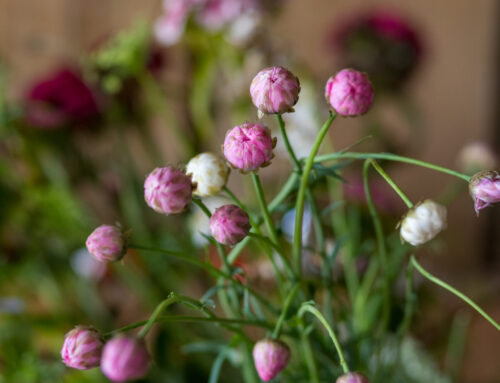Browse any vegetable or flower growing publication and the issue of compost very quickly comes to the fore.
In some articles, there can be a lot of complexity added to the process of making good quality compost, with talk of layers and various ratios. For us, we try to stick to basic principles and keep it simple.
First, back to basics. Why do we need to “add” compost to our soil? In simple terms, all flowers that leave Tara Hill in a box or bouquet take some key nutrients with them. Every trailer load of compost that arrives onto the farm brings some back. Like everything in life, it is all about balance.
Both myself and my husband Pat are Agricultural Science graduates, so we have the science background to understand the needs of the plant and the requirement to feed the soil. We also grew up on farms, which certainly helps.
Plants generally require nutrients such as nitrogen (N), phosphorous (P), potassium (K), calcium (Ca), magnesium (Mg), sulphur (S), manganese (Mn), copper (Cu), zinc (Zn), chlorine (Cl), boron (B), iron (Fe), and molybdenum (Mo). Look at the label on a box or bottle of plant food or fertilizer and you will see them listed, alongside a percentage inclusion rate.
One of the first things we did was to undertake a soil test – take a representative sample of soil from our field and our poly tunnel and have it professionally analysed for the above nutrients in a laboratory. The results were as expected – our soil was extremely low in key nutrients such as potassium and phosphorus. This was not a surprise, as prior to our purchase of the property in 2018, the land had been grazed by horses and didn’t get a whole lot of attention.
By adding compost to the soil, we are improving the texture and making more nutrients available. There are other benefits too, such as improved ability to retain moisture.
Like making a cake, to create good quality compost, you need good ingredients, suitable conditions and the requisite amount of time. Nature will generally take care of the rest.
We have a range of sources for our compost:
- Suitable food waste from our home is placed in compost bins and left to its own devices. We did add some worms in the early days (once) and they seem to be still there doing their magic. Note the use of the word bins, rather than bin. By spreading it across three, they are in various stages of decomposition and not flooded with fresh food.
- Hen manure is placed in layers in one of these bins – we call it the “rocket fuel” bin as it will be very high in some nutrients such as potassium (two scoops of pellets per day, minus the eggs is a lot of nutrients). We have to be selective in where we use this material.
- We have three open bays created using pallets to capture lawn clippings, hedge trimmings, surplus vegetables and some weeds (those not gone to seed).
- Our neighbour drops some horse stable manure. Another delivers some cattle manure (straw based). We leave this material break down in an open heap for at least 12 months (it might work quicker if we covered it but that would be an extra job).
- We collect coffee grounds from a local outlet and add them to the various piles.
- Over-ripe flowers are discarded in a separate pile as some will contain seeds that we don’t necessarily want to spread all over the beds.
We have plenty space so all of the above are given plenty time to break down into a nice friable material. In general, the material is applied in late autumn and can be broken down over the winter. We also grow some vegetables such as pumpkins and sweetcorn that love growing in a bed that contains large amounts of composted material.
Weed seeds inevitably arise from some of the outside sources, which is one of the challenges to be managed and makes it all the more important to know where your compost is coming from.





Leave A Comment